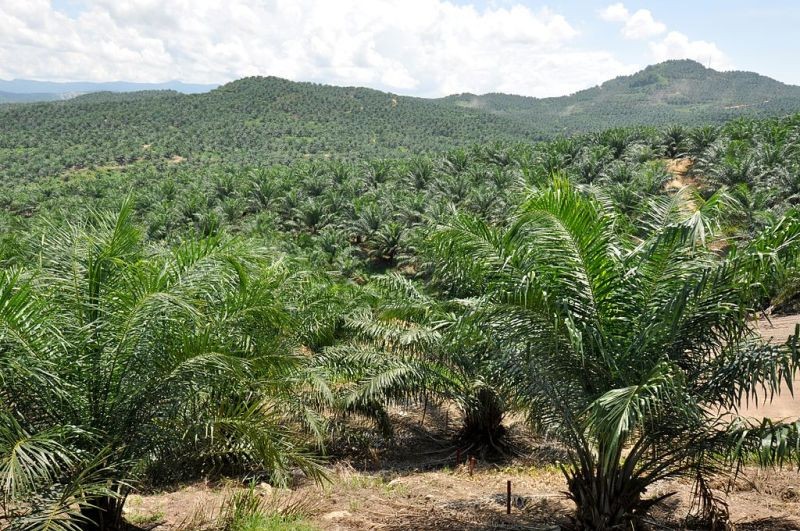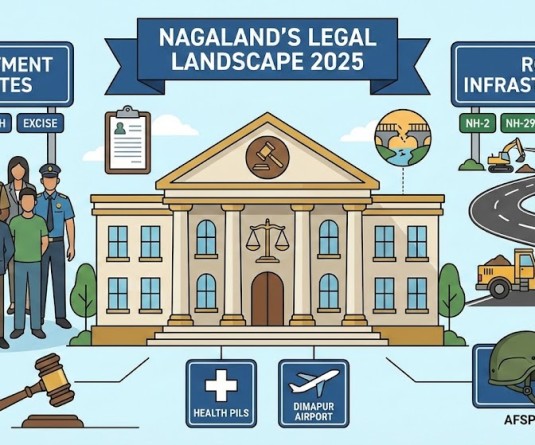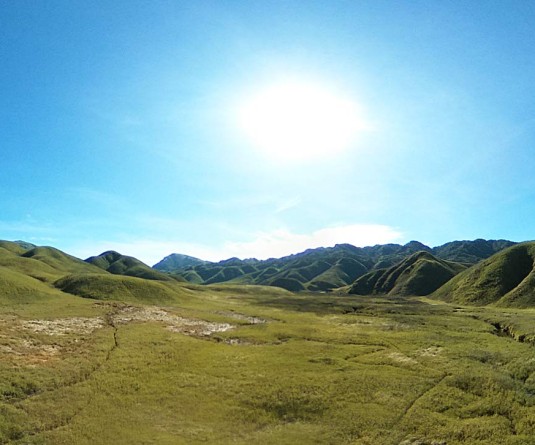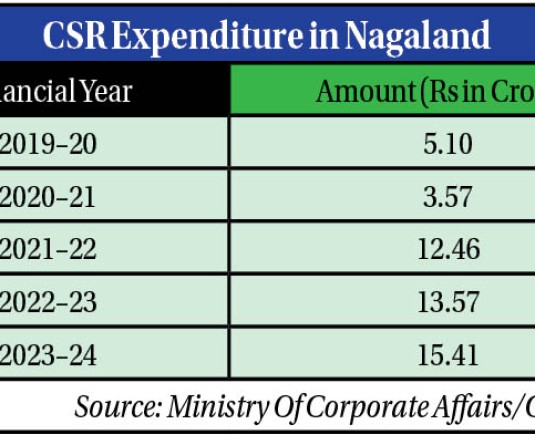Representative Image: A large expanse of monoculture oil palm plantation in Sabah, Malaysian Borneo. Oil Palm plantation, a comparatively a new crop in India, is increasing at a rapid pace in Nagaland starting with an area of 140 hectare (ha) in 2015-16 to 4623 ha in 2020-21 as of .March 31, 2021. (Image: T. R. Shankar Raman, CC BY-SA 4.0 <https://creativecommons.org/licenses/by-sa/4.0>, via Wikimedia Commons)

Moa Jamir
Dimapur | August 30
Nagaland’s tryst with oil palm plantation started with a mere 140 hectares (ha) in 2015-16 under the National Mission on Oilseed and Oil Palm (NMOOP). In just around six years on March 31, 2021, the coverage area was 4,623 ha in 7 districts, denoting a massive 3,202.14% increase.
With the recent Union Cabinet approval for the implementation of a new Centrally Sponsored Scheme (CSS) called National Mission on Edible Oils – Oil Palm (NMEO-OP) with a special focus on the North East and the Andaman region on August 18, the plantation may increase further.
According a Department of Agriculture (DoA) document, the State government has set a target of 15,000 ha for the state covering foot hills in 7 districts.
With the announcement of the NMEO-OP with financial outlay of Rs 11,040 crore and focusing on “increasing area and productivity of oilseeds and Oil Palm,” the goalpost might change.
However, experts have cautioned over the possible impact of oil palm cultivation on environment, particularly on biodiversity and its sustainability.
In a two-part series, The Morung Express explores the concerns shared by experts on the push for monoculture and oil palm plantation in the State as well as some way forward for the perpetual environment versus economic development debate.
Monoculture: A concerning ‘development’
Monoculture, as per the Oxford Dictionary, means “the cultivation of a single crop in a given area.”
“It has never been our tradition; we have sustained generations after generation feeding ourselves without the need for it,” maintained Abokali Jimomi, an activist promoting local products, organic and sustainable farming.
“It is exactly the opposite of our traditional jhum agriculture where a diverse range of over 60-70 different crops were grown in one small patch of land producing enough nutrient-rich, organic food for a household,” she noted.
“The land use with long cycles of leaving it fallow was not nutrient-depleting and destructive,” Jimomi maintained.
Monoculture and biodiversity are two parallel lines. It's a sad irony to see a nation adopting UNDSGS (United Nation Sustainable Development Goals) on one hand and on the other promoting monoculture, stated Dr Martemjen, an Indigenous and Human Rights activist.
Be it palm oil or any other, it is an enemy to indigenous culture, he asserted adding, “There is no biodiversity in monoculture as the name itself indicates.”
Dr Martemjen who is also the author of “Biodiversity Conservation, Indigenous Knowledge and practices: A Naga Perspective,” monoculture is an “economic business/activity afforded by the rich and designed for the affluent section of society.”
“The trend of purchasing vast acres of land from the poor and marginalized villages by the rich and affluent has become a habit in Nagaland, and such lands are being used by to practice monoculture and other business by the same,” he added.
For Policy Analyst and Development Advisor, Amba Jamir, “Disturbing the land use and cropping systems by introducing exotic species and that too in large areas as monocultures would be a terrible mistake.”
“Hopefully our state government and our communities will reject any idea that threatens our biodiversity,” he said, noting that Nagaland is nestled within the Eastern Himalayan Biodiversity hotspot, including the rich agro-biodiversity farmers are maintaining for generations in their fields.
Enter oil palm plantation
There is growing popularity among the farming community for oil palm cultivation in recent years after the introduction of NMOOP, observed Professor Tongpang Longkumer of Nagaland University’s School of Agricultural Science and Rural Development (SASRD).
The recent announcement by the Union Government may significantly increase its cultivation areas, he said.
Experts, however, are clear on exercising caution when it comes to oil palm plantation.
Nagaland is situated in Indo Myanmar Biodiversity Hot Spot and communities have preserved CCA (Community Conservation Areas). A study by TERI (The Energy Research Institute) New Delhi in 2014 found out those CCAs are only “left out” areas with rich forest and rich biodiversity, informed M Lokeswara Rao, former Principal Chief Conservator of Forests & Head of Forest Force, Nagaland.
By introducing oil palm plantation, these areas may be invested by the plantation crops, he feared.
“We should learn the devastating effect of palm oil cultivation of South East Asian countries like Indonesia where the fragile forests are replaced by monoculture. People are repenting. No Forest means no life,” Rao added.
“The business and maintenance of Oil Palm plantations I am told is very lucrative and quite trouble free,” informed Jamir.
However, it is not about “business or livelihood opportunities but on the long-term, social and environmental impacts that almost seem to come bundled with oil palm plantations,” he asserted.
“The announcement is also mired in controversy as there are numerous advisories discouraging such activities,” he added.
Both Jimomi and Dr Martemjen were unequivocal in calling for treading cautiously.
“Displacement of indigenous people, rainforest destruction, loss of habitat, loss of livelihood source of locals are directly related to palm oil production -- owned, operated and profited by multinational companies around the world,” Jimomi noted.
For Dr Martemjen, it was “heart wrenching” to see exploitation of the poor and the land itself by the so “called learned class in our state.”
“Encouraging the farmers whose livelihood depends on their daily and yearly harvest, to practice such practices which gives yield after 5/10/20 years (palm oil, rubber, teak etc) in itself is a crime,” he said.
From cultural perspective, he noted that traditional Nagas land is their identity. “The moment we have away our land to an alien force we lose that identify so we need to educate the villagers from all aspects rather than exploit them.”
While highlighting that there is great potential for great potential for oil seeds sector considering the diverse agro-ecological conditions of Nagaland, Prof Tongpang also advocated for meticulous planning and strategic approach towards its implementation.
Among others, it should take into account the vulnerability of the land towards ecological disturbance due to factors such as rampant deforestation to accommodate cultivation and conversion of fertile arable lands into monoculture of such plantations, he added.
This is the first of a two-part series
Read Related Reports:
LOOK BEFORE YOU LEAP: Nagaland’s tryst with oil palm plantation-II
Oil Palm Plantation in Nagaland: From 140 to 4623 ha in 6 years






